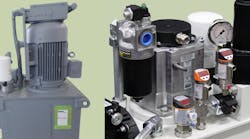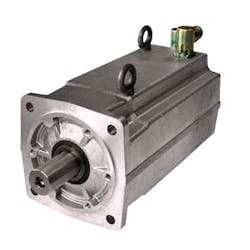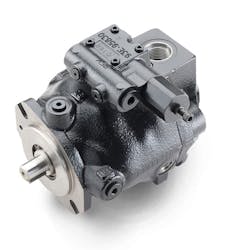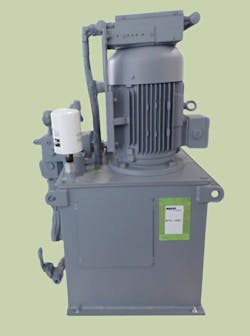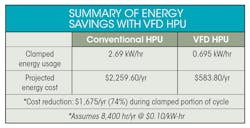A user’s request for an HPU design that would eliminate a free-standing unit and all its plumbing on the factory floor, and instead be incorporated into a machine structure, led to a compact system that also is more energy-efficient at a lower overall cost. The new unit was designed by MFP Automation Engineering.
It provides clamping force during a testing phase in the user’s machine cycle. During that phase, it provides high flow to move a part rapidly into the clamp position but needs almost no flow to remain clamped at pressure until the test phase is complete. At the end of the test phase, it again provides high flow for unclamping and part removal. Because the high flow is only required for approximately 6 sec. of an 81-sec. test cycle, the application was an ideal candidate for energy reduction.
The reductions in size and energy consumption were made possible primarily by switching from a typical induction motor to a PMAC motor with a VFD controller. Moving the unit from the factory floor to the machine envelope makes additional floor space available for other uses. Total energy savings at full flow are approximately 10% because the PMAC motor eliminates the magnetizing current that occurred with the induction motor. The most significant energy reduction occurs during the clamped phase of the machine cycle because the motor speed is reduced. The new design also reduces overall system costs. Although net costs of major components for the VFD and PMAC motor design are approximately 10% higher, simplification of the valves required to control the unit resulted in lower overall costs.
System Components
The HPU is driven by a Parker Hannifin NX series brushless servomotor with a continuous nominal torque rating of 132 lb-in. (15 N-m) and intermittent power capabilities of up to 13.6 hp (10.1 kW). For the majority of the machine’s cycle time, during which its operation is sequential, it delivers a nominal 4.6 hp (3.4 kW) at 2,200 rpm, although it can range between 1.3 hp (0.97 kW) and 6.7 hp (4.9 kW) during this phase. Motor speed is controlled by the machine cycle, based on flow demands of the various functions. This eliminates the need for separate flow controls and minimizes wasted energy.
